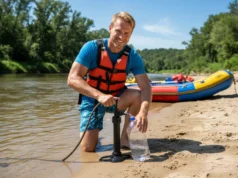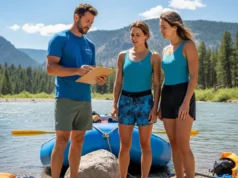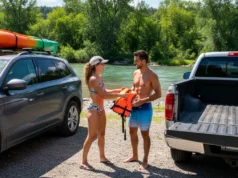In this article
You’re deep in the Grand Canyon, days from the nearest road. A member of your group has a serious injury, and the canyon walls block all cell service. In this moment, the small device clipped to your PFD isn’t just a gadget—it’s your only link to help. Choosing that device is one of the most critical gear decisions a river runner can make for their emergency preparedness and backcountry safety. This guide cuts through the marketing noise to provide a definitive, river-tested framework for selecting the most reliable satellite messenger for your specific needs.
To get there, we’ll show you why the satellite network itself is the single most important factor for satellite connection performance in canyon environments, making Low Earth Orbit (LEO) satellite systems like the Iridium satellite constellation the non-negotiable choice for true global coverage. We’ll go beyond simple “waterproof” ratings to evaluate true “river-ready” durability, from seals that resist sand to a tactile physical keyboard or buttons you can actually use with cold, wet hands, ensuring good user interface ease. You’ll meet three distinct river runner personas—The Expedition Guide, The Weekend Whitewater Warrior, and The Family Float Trip Organizer—and we’ll match them with the perfect devices for their needs. Finally, we’ll demystify the total cost, looking at everything from the initial price to the crucial flexibility of subscription plans, ensuring you invest wisely for the long haul.
How to Choose the Right Satellite Messenger for Rivers: An Expert’s Framework
This isn’t about memorizing specs. This river-focused guide is about building an expert’s mindset. Our goal is to arm you with the objective knowledge to make a smart, confident choice, moving beyond generic features to understand what “river-readiness” truly means.
Why is Satellite Network & Canyon Performance the #1 Factor?
Before you ever look at a device’s battery life or button layout, you must understand the satellite communication network it runs on. On a river, this is everything. The fundamental challenge of a deep, narrow river canyon is what we call a “reduced sky view.” These specific river-specific challenges and canyon communication challenges mean towering rock walls can block a huge portion of the horizon, severely limiting a device’s satellite visibility. This is where the difference between network types becomes a life-or-death matter.
Some satellite networks, like the Globalstar satellite network, use geostationary satellite (GEO) technology that sit in a fixed position high above the Earth. If a canyon wall or cliff band blocks that fixed point, your signal coverage and signal reliability drop to zero. Period. In contrast, Iridium satellite networks use a “mesh” of many fast-moving communications satellites that constantly crisscross the sky. Even with a limited view, a new satellite will typically move into your line of sight within minutes. This constant-motion swarm provides superior reliability when terrain would otherwise leave you in a communication black hole. For this reason, a device on the Iridium network is the gold standard for river use, delivering proven global satellite coverage and unmatched performance in obstructed environments. It’s not just a feature; it’s the foundation of a reliable lifeline and a core component of a comprehensive river rescue kit. The technology is validated by the same international body that coordinates global search and rescue, the international COSPAS-SARSAT satellite system. Once you’ve confirmed a reliable network, the next step is ensuring the device itself can survive the physical demands of a river trip.
How Durable and Waterproof Does a River Messenger Need to Be?
The term “waterproof” is thrown around loosely in marketing, but on a river, the details are what keep your gear functioning. The standard for this is the IP Code system, which you can learn more about from the International Electrotechnical Commission (IEC). For any electronic device you bring on the water, a waterproof rating of IPX7 should be considered the absolute minimum. This means the device can be fully submerged in 1 meter of water for 30 minutes without failing. While that handles an accidental swim, a superior waterproof rating like IPX8/IP68 adds a crucial layer of protection. The “6” in IP68 signifies that the device is completely sealed against fine particles like dust, sand, and river silt, which can easily work their way into charging ports and button seams, causing long-term damage.
Pro-Tip: Don’t just clip your messenger to your PFD and forget it. On a multi-day trip, take a moment each evening to rinse the device with fresh, clean water to clear any accumulated silt or sand from the charging port and button housings. Let it air dry completely before charging. This simple habit dramatically extends the life of your gear.
But true river-ready durability testing goes beyond an IP rating. Look for devices with durability ratings (MIL-STD-810) for shock resistance, which means it’s built to survive drops and impacts. Most importantly, consider the physical interface. In the cold rain, with numb fingers or while wearing paddling gloves, trying to operate a tiny touchscreen is an exercise in futility. Tactile, physical buttons are non-negotiable for critical SOS functionality. A bombproof device is useless if its battery dies on day two of a week-long trip.
What Defines Great Battery Life and Power Management on the Water?
Exceptional battery life (battery longevity) isn’t a convenience on a river trip; it’s a core safety feature that reduces the need to carry and manage heavy, bulky power banks like an Anker Portable Charger. To make a fair, apples-to-apples comparison between devices, always look at the manufacturer’s stated battery life while using a standard “10-minute tracking intervals,” as this directly impacts battery performance in wet conditions over a long trip.
Beyond the battery itself, consider the charging method and ecosystem. A modern satellite device should use a USB-C port. This isn’t just about faster charging; it’s about reducing cable clutter and standardizing your power kit. You can use the same cable to charge your messenger, your headlamp, and your phone, simplifying your entire system. Some of the best modern satellite messengers even offer reverse charging and various power saving modes, allowing the messenger to act as a tiny power bank. This can be a trip-saving feature, giving a dead phone just enough juice to view a map or type out a detailed emergency message through the device’s app. With power and durability sorted, let’s look at what these devices actually do—their communication abilities.
Which Messaging Features Actually Matter on a River Trip?
The capabilities of satellite messengers range from simple one-way custom preset messages to full two-way messaging. A basic “I’m OK” message, one of several custom preset messages you can configure, is great for routine check-ins, but in a real emergency, the value of two-way satellite messaging cannot be overstated, especially for emergency messaging. Being able to have a detailed conversation with the GEOS emergency response center—describing the nature of an injury, the patient’s vitals, or your exact location relative to a known landmark—transforms emergency response coordination from a blind operation into a coordinated, efficient rescue. This detailed back-and-forth, with message delivery confirmation, provides immense peace of mind and can genuinely improve outcomes.
Advanced features like group tracking features can also be incredibly useful for coordinating logistics between multiple rafts on a private trip, allowing you to discuss a change of plans or decide on a campsite without having to paddle within shouting distance. Some devices, unlike those with temporary SMS lines, even offer a dedicated, permanent phone number, which simplifies communication for friends and family at home who can text you just as they would anyone else. But the best features are meaningless if you can’t access them when your phone is dead or lost—a common river scenario.
Why is Standalone Functionality a Non-Negotiable Safety Feature?
Satellite communicators fall into two main categories: high-standalone-functionality units with on-device screens and buttons, and low-functionality “hotspots” that are completely reliant on a paired smartphone, which introduces app complexity and a single point of failure. A smartphone is extremely vulnerable in a river environment; it can be destroyed by water, its battery can die, or it can be lost overboard in a flip. Relying on it as the sole interface for your emergency device creates a critical point of failure.
This is why standalone operation capability is a non-negotiable safety feature. You must be able to trigger an SOS button, send a preset “I’m OK” message, and see a message delivery confirmation, all without ever touching your phone. Choosing a device with this level of on-device functionality is a fundamental decision between operational redundancy and a lower cost. Finally, let’s analyze the true financial commitment required to own and operate one of these critical safety tools.
How Should I Evaluate the Total Cost of Ownership?
The true cost of a satellite messenger is a combination of the initial device price/MSRP and the recurring subscription cost. A low initial price can sometimes be a red flag, masking expensive or inflexible plans that make it a costlier option over the long term. It’s crucial to understand the difference between rigid annual plans and the flexible “monthly” or “flex” subscription plans offered by brands like Garmin and ZOLEO.
For seasonal users like most river runners, flexible subscription plans that allow service to be suspended during the off-season are far more economical. You pay for the months you actually need it and can pause the service when your boat is in storage. Be sure to check for any activation fee or other charges that might be hidden in the fine print. By evaluating the total cost of ownership over a two or three-year period, you get a much clearer picture of your investment.
Our Selection Process: How We Built This Guide
To build this guide, we committed to a process of absolute transparency and objectivity. We are not sponsored by any brand; this is based on our real-world experience.
Every product we considered was systematically scored against the “6 Pillars of River-Readiness” we just detailed: Signal Reliability, Durability (including IPX7 and MIL-STD-810 ratings), Battery Life (tested at standard tracking intervals), Messaging (including two-way capability and SOS functionality), Standalone Operation Capability, and Total Cost (including device MSRP, subscription cost, and activation fees). We began with a comprehensive analysis of the entire 2025 satellite messenger market, then filtered that list down to only include tier-1 options that meet the non-negotiable criteria for rafting scenarios and kayaking scenarios, such as using the Iridium satellite network and having a minimum IPX7 rating. From there, we curated the top performers and matched them to the user personas who would benefit most.
A quick note on affiliate links: If you choose to purchase a product through one of our links, we may earn a small commission at no extra cost to you. This helps support our work and allows us to continue providing in-depth, unbiased guides. We only recommend gear we believe in.
The Best Satellite Messengers for Rivers of 2025: Our Top Recommendations for Every Need
The right device isn’t a one-size-fits-all solution. It’s a personal choice based on your trip style, risk tolerance, and budget. Here are our curated recommendations, broken down by the key user personas we see on the river every day.
Our Top Picks for “The Expedition Guide”
This user demands the absolute best in signal reliability, features, and standalone operation. They are leading complex, multi-week expeditions where failure is not an option. For them, cost is a secondary concern to capability and redundancy. They need a tool that is as serious and dependable as they are.
Our Top Picks for “The Weekend Whitewater Warrior”
This user is a serious and skilled paddler who pushes their limits on challenging day trips or weekend overnighters. They prioritize a compact, lightweight (portability), and extremely durable satellite communicator that can be worn directly on a PFD for instant access, which is one of the key device mounting solutions for river environments. Standalone functionality for quick, phone-free messages is critical, as are flexible subscription plans for seasonal use.
Pro-Tip: When mounting a device to your PFD, use both the included carabiner and a secondary tether tied to a secure point on the shoulder strap. This redundancy ensures that if the carabiner gate is accidentally opened by a branch or rope, your lifeline remains attached to you, not at the bottom of the river.
Our Top Picks for “The Family Float Trip Organizer”
This user’s top priorities are simplicity, affordability, and ease of use for non-emergency messaging with contacts back home. A “fire-and-forget” device for check-ins and a dependable SOS function are more important than advanced features. They need a tool that gives the family peace of mind without a steep learning curve.
Conclusion
Choosing the right satellite messenger comes down to a few core principles. First and foremost, the network is paramount. For the challenging terrain of river canyons, a satellite communicator on the Iridium satellite network is the only choice for reliable performance. Durability is also key; a minimum waterproof rating of IPX7 and tactile physical buttons are non-negotiable for the wet and rugged river environment. Redundancy truly matters, as the ability to perform critical functions without a smartphone (standalone operation) is a vital backcountry safety feature that separates the best devices from mere accessories. Ultimately, the best device isn’t the most expensive one; it’s the one that perfectly aligns with your specific needs, whether you’re a professional guide, a weekend warrior, or a family trip leader.
Armed with this expert framework, revisit the recommendations for your river runner persona and invest confidently in the satellite messenger that will keep you connected and safe on your next adventure.
Frequently Asked Questions about Satellite Messengers for Rivers
Do I need a satellite messenger if I already have a Personal Locator Beacon (PLB)?
A satellite messenger is highly recommended even if you have a PLB. While a Personal Locator Beacon (PLB), like an ACR Electronics rescueME PLB1, is excellent for a one-way SOS signal, its key limitation is that you cannot provide details or receive confirmation. A messenger’s two-way communication allows you to describe the emergency to rescuers, receive medical advice, and know that help is on the way, which significantly reduces anxiety and improves outcomes. Modern devices like the [Garmin inReach Mini 2] offer robust two-way messaging in a package that is just as small and light as a traditional PLB.
Which satellite network is best for deep river canyons?
The Iridium satellite network is unequivocally the best choice for deep river corridors and canyons. Its constellation of many Low Earth Orbit (LEO) satellites moves continuously across the sky, which ensures that even with a very limited view of the sky blocked by canyon walls, a satellite is likely to come into view quickly. This provides a much more reliable satellite connection and consistent signal reliability than geostationary satellite networks. All of the top-rated devices in our guide, such as the [ZOLEO Satellite Communicator], use the Iridium network for this very reason.
Can I pause my satellite messenger subscription during the off-season?
Yes, absolutely. This is a key consideration for seasonal rafters. Brands like Garmin and ZOLEO offer flexible monthly subscription plans that allow you to suspend service for a small fee during the months you aren’t on the river. This is far more economical than being locked into a rigid annual subscription plan. For those who paddle very infrequently, the ACR Electronics Bivy Stick offers extremely flexible credit-based plans with flexible activation where your unused messages can roll over, providing even greater value.
Is a more expensive satellite messenger always better?
Not necessarily. The “best” device depends entirely on your needs and how you’ll use it. For a family prioritizing simplicity and ease of use for contacts at home, an affordable, budget-friendly satellite messenger like the [$200 ZOLEO Satellite Communicator] is a better choice than a complex, feature-heavy unit. Conversely, for a professional guide who relies on the device for navigation and logistics in extreme environments, the robust on-device functionality and GPS navigation features of a [$600 Garmin GPSMAP 67i] are a worthwhile investment. Match the device to your persona, not the price tag.
Risk Disclaimer: Whitewater rafting, kayaking, and all related river sports are inherently dangerous activities that can result in serious injury, drowning, or death. The information provided on Rafting Escapes is for educational and informational purposes only. While we strive for accuracy, the information, techniques, and safety advice presented on this website are not a substitute for professional guide services, hands-on swiftwater rescue training, or your own critical judgment. River conditions, including water levels, currents, and hazards like strainers or undercut rocks, change constantly and can differ dramatically from what is described on this site. Never attempt to navigate a river beyond your certified skill level and always wear appropriate safety gear, including a personal flotation device (PFD) and helmet. We strongly advise rafting with a licensed professional guide. By using this website, you agree that you are solely responsible for your own safety. Any reliance you place on our content is strictly at your own risk, and you assume all liability for your actions and decisions on the water. Rafting Escapes and its authors will not be held liable for any injury, damage, or loss sustained in connection with the use of the information herein.
Affiliate Disclosure: We are a participant in the Amazon Services LLC Associates Program, an affiliate advertising program designed to provide a means for us to earn advertising fees by advertising and linking to Amazon.com. As an Amazon Associate, we earn from qualifying purchases. We also participate in other affiliate programs and may receive a commission on products purchased through our links, at no extra cost to you. Additional terms are found in the terms of service.





